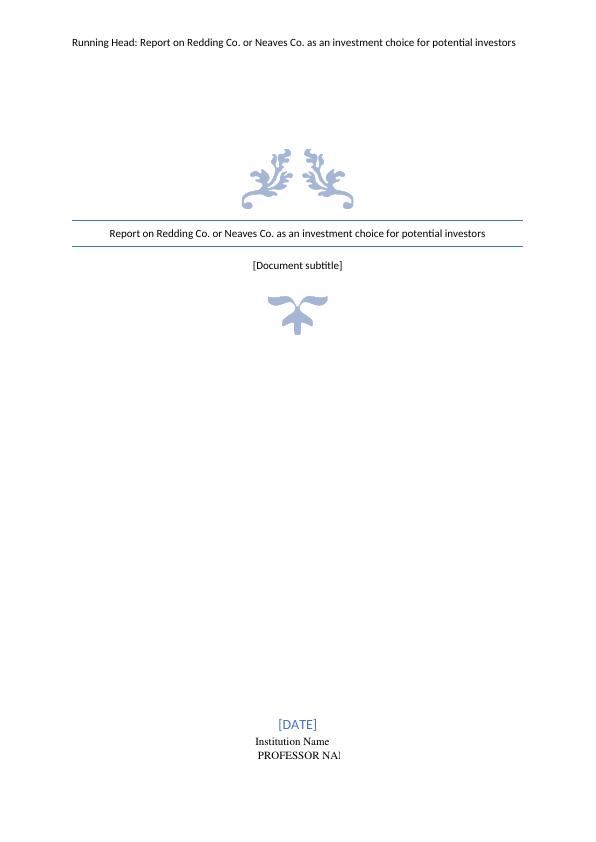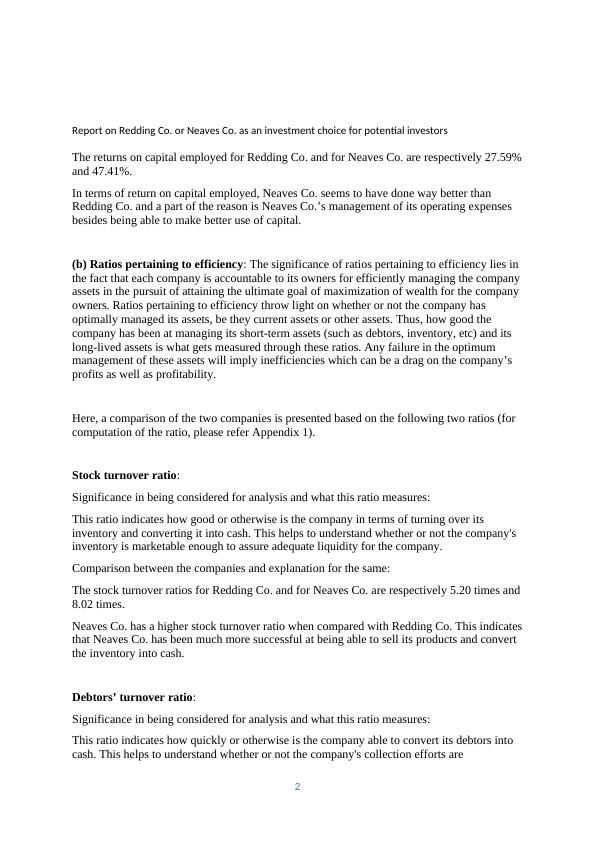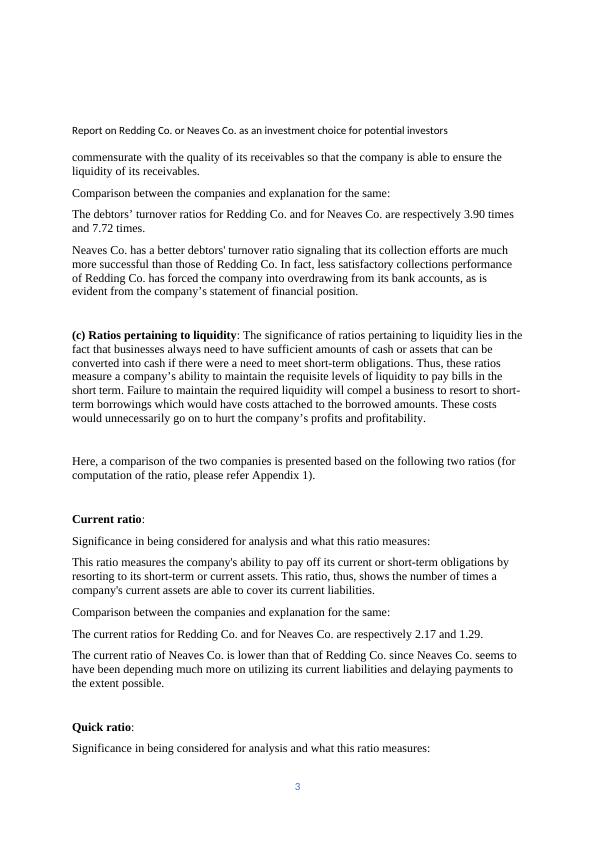Report on Redding Co. or Neaves Co. as an investment choice for potential investors
Added on 2023-06-07
16 Pages3844 Words436 Views
Running Head: Report on Redding Co. or Neaves Co. as an investment choice for potential investors
Report on Redding Co. or Neaves Co. as an investment choice for potential investors
[Document subtitle]
[DATE]
Report on Redding Co. or Neaves Co. as an investment choice for potential investors
[Document subtitle]
[DATE]

Report on Redding Co. or Neaves Co. as an investment choice for potential investors
Section 1: Corporate performance analysis through financial ratios:
(a) Ratios pertaining to profitability: The significance of ratios pertaining to profitability
comes from the ability of these ratios to give an idea of how the absolute amounts of the
profits made by a business stack up vis-à-vis other amounts such as capital employed in the
business or sales effected by the business or the like. Often, the amount of profit alone may
look attractive but only when this amount is related with or linked to another number (such as
capital employed, sales, etc) does the real picture emerge in terms of whether these profits are
sufficient/justifiable or not. While profit is an absolute concept, profitability is a relative
concept.
Here, a comparison of the two companies is presented based on the following two ratios (for
computation of the ratio, please refer Appendix 1).
Net profit margin:
Significance in being considered for analysis and what this ratio measures:
This ratio is significant given that it measures a company’s profit which remains after the
company has met its operating costs.
Comparison between the companies and explanation for the same:
The net profit margins for Redding Co. and for Neaves Co. are respectively 41.02% and
47.90%.
Neaves Co. did a comparatively better job at managing its operating costs so that the
company ends up with a better net profit margin as compared to Redding Co. This is worth
appreciating given that this company is newer and has grown through acquisitions; the
company seems to have done well in ensuring proper control over operating costs.
Return on capital employed:
Significance in being considered for analysis and what this ratio measures:
This ratio is significant in that it reflects the percentage of profits before interest and taxes
that a company's capital employed is able to fetch to the company. Profits before interest are
considered here since this profit figure is of relevance to those expecting interest payments
from the company (debt capital providers) and those expecting dividends from the company
(shareholders).
Comparison between the companies and explanation for the same:
1
Section 1: Corporate performance analysis through financial ratios:
(a) Ratios pertaining to profitability: The significance of ratios pertaining to profitability
comes from the ability of these ratios to give an idea of how the absolute amounts of the
profits made by a business stack up vis-à-vis other amounts such as capital employed in the
business or sales effected by the business or the like. Often, the amount of profit alone may
look attractive but only when this amount is related with or linked to another number (such as
capital employed, sales, etc) does the real picture emerge in terms of whether these profits are
sufficient/justifiable or not. While profit is an absolute concept, profitability is a relative
concept.
Here, a comparison of the two companies is presented based on the following two ratios (for
computation of the ratio, please refer Appendix 1).
Net profit margin:
Significance in being considered for analysis and what this ratio measures:
This ratio is significant given that it measures a company’s profit which remains after the
company has met its operating costs.
Comparison between the companies and explanation for the same:
The net profit margins for Redding Co. and for Neaves Co. are respectively 41.02% and
47.90%.
Neaves Co. did a comparatively better job at managing its operating costs so that the
company ends up with a better net profit margin as compared to Redding Co. This is worth
appreciating given that this company is newer and has grown through acquisitions; the
company seems to have done well in ensuring proper control over operating costs.
Return on capital employed:
Significance in being considered for analysis and what this ratio measures:
This ratio is significant in that it reflects the percentage of profits before interest and taxes
that a company's capital employed is able to fetch to the company. Profits before interest are
considered here since this profit figure is of relevance to those expecting interest payments
from the company (debt capital providers) and those expecting dividends from the company
(shareholders).
Comparison between the companies and explanation for the same:
1

Report on Redding Co. or Neaves Co. as an investment choice for potential investors
The returns on capital employed for Redding Co. and for Neaves Co. are respectively 27.59%
and 47.41%.
In terms of return on capital employed, Neaves Co. seems to have done way better than
Redding Co. and a part of the reason is Neaves Co.’s management of its operating expenses
besides being able to make better use of capital.
(b) Ratios pertaining to efficiency: The significance of ratios pertaining to efficiency lies in
the fact that each company is accountable to its owners for efficiently managing the company
assets in the pursuit of attaining the ultimate goal of maximization of wealth for the company
owners. Ratios pertaining to efficiency throw light on whether or not the company has
optimally managed its assets, be they current assets or other assets. Thus, how good the
company has been at managing its short-term assets (such as debtors, inventory, etc) and its
long-lived assets is what gets measured through these ratios. Any failure in the optimum
management of these assets will imply inefficiencies which can be a drag on the company’s
profits as well as profitability.
Here, a comparison of the two companies is presented based on the following two ratios (for
computation of the ratio, please refer Appendix 1).
Stock turnover ratio:
Significance in being considered for analysis and what this ratio measures:
This ratio indicates how good or otherwise is the company in terms of turning over its
inventory and converting it into cash. This helps to understand whether or not the company's
inventory is marketable enough to assure adequate liquidity for the company.
Comparison between the companies and explanation for the same:
The stock turnover ratios for Redding Co. and for Neaves Co. are respectively 5.20 times and
8.02 times.
Neaves Co. has a higher stock turnover ratio when compared with Redding Co. This indicates
that Neaves Co. has been much more successful at being able to sell its products and convert
the inventory into cash.
Debtors’ turnover ratio:
Significance in being considered for analysis and what this ratio measures:
This ratio indicates how quickly or otherwise is the company able to convert its debtors into
cash. This helps to understand whether or not the company's collection efforts are
2
The returns on capital employed for Redding Co. and for Neaves Co. are respectively 27.59%
and 47.41%.
In terms of return on capital employed, Neaves Co. seems to have done way better than
Redding Co. and a part of the reason is Neaves Co.’s management of its operating expenses
besides being able to make better use of capital.
(b) Ratios pertaining to efficiency: The significance of ratios pertaining to efficiency lies in
the fact that each company is accountable to its owners for efficiently managing the company
assets in the pursuit of attaining the ultimate goal of maximization of wealth for the company
owners. Ratios pertaining to efficiency throw light on whether or not the company has
optimally managed its assets, be they current assets or other assets. Thus, how good the
company has been at managing its short-term assets (such as debtors, inventory, etc) and its
long-lived assets is what gets measured through these ratios. Any failure in the optimum
management of these assets will imply inefficiencies which can be a drag on the company’s
profits as well as profitability.
Here, a comparison of the two companies is presented based on the following two ratios (for
computation of the ratio, please refer Appendix 1).
Stock turnover ratio:
Significance in being considered for analysis and what this ratio measures:
This ratio indicates how good or otherwise is the company in terms of turning over its
inventory and converting it into cash. This helps to understand whether or not the company's
inventory is marketable enough to assure adequate liquidity for the company.
Comparison between the companies and explanation for the same:
The stock turnover ratios for Redding Co. and for Neaves Co. are respectively 5.20 times and
8.02 times.
Neaves Co. has a higher stock turnover ratio when compared with Redding Co. This indicates
that Neaves Co. has been much more successful at being able to sell its products and convert
the inventory into cash.
Debtors’ turnover ratio:
Significance in being considered for analysis and what this ratio measures:
This ratio indicates how quickly or otherwise is the company able to convert its debtors into
cash. This helps to understand whether or not the company's collection efforts are
2

Report on Redding Co. or Neaves Co. as an investment choice for potential investors
commensurate with the quality of its receivables so that the company is able to ensure the
liquidity of its receivables.
Comparison between the companies and explanation for the same:
The debtors’ turnover ratios for Redding Co. and for Neaves Co. are respectively 3.90 times
and 7.72 times.
Neaves Co. has a better debtors' turnover ratio signaling that its collection efforts are much
more successful than those of Redding Co. In fact, less satisfactory collections performance
of Redding Co. has forced the company into overdrawing from its bank accounts, as is
evident from the company’s statement of financial position.
(c) Ratios pertaining to liquidity: The significance of ratios pertaining to liquidity lies in the
fact that businesses always need to have sufficient amounts of cash or assets that can be
converted into cash if there were a need to meet short-term obligations. Thus, these ratios
measure a company’s ability to maintain the requisite levels of liquidity to pay bills in the
short term. Failure to maintain the required liquidity will compel a business to resort to short-
term borrowings which would have costs attached to the borrowed amounts. These costs
would unnecessarily go on to hurt the company’s profits and profitability.
Here, a comparison of the two companies is presented based on the following two ratios (for
computation of the ratio, please refer Appendix 1).
Current ratio:
Significance in being considered for analysis and what this ratio measures:
This ratio measures the company's ability to pay off its current or short-term obligations by
resorting to its short-term or current assets. This ratio, thus, shows the number of times a
company's current assets are able to cover its current liabilities.
Comparison between the companies and explanation for the same:
The current ratios for Redding Co. and for Neaves Co. are respectively 2.17 and 1.29.
The current ratio of Neaves Co. is lower than that of Redding Co. since Neaves Co. seems to
have been depending much more on utilizing its current liabilities and delaying payments to
the extent possible.
Quick ratio:
Significance in being considered for analysis and what this ratio measures:
3
commensurate with the quality of its receivables so that the company is able to ensure the
liquidity of its receivables.
Comparison between the companies and explanation for the same:
The debtors’ turnover ratios for Redding Co. and for Neaves Co. are respectively 3.90 times
and 7.72 times.
Neaves Co. has a better debtors' turnover ratio signaling that its collection efforts are much
more successful than those of Redding Co. In fact, less satisfactory collections performance
of Redding Co. has forced the company into overdrawing from its bank accounts, as is
evident from the company’s statement of financial position.
(c) Ratios pertaining to liquidity: The significance of ratios pertaining to liquidity lies in the
fact that businesses always need to have sufficient amounts of cash or assets that can be
converted into cash if there were a need to meet short-term obligations. Thus, these ratios
measure a company’s ability to maintain the requisite levels of liquidity to pay bills in the
short term. Failure to maintain the required liquidity will compel a business to resort to short-
term borrowings which would have costs attached to the borrowed amounts. These costs
would unnecessarily go on to hurt the company’s profits and profitability.
Here, a comparison of the two companies is presented based on the following two ratios (for
computation of the ratio, please refer Appendix 1).
Current ratio:
Significance in being considered for analysis and what this ratio measures:
This ratio measures the company's ability to pay off its current or short-term obligations by
resorting to its short-term or current assets. This ratio, thus, shows the number of times a
company's current assets are able to cover its current liabilities.
Comparison between the companies and explanation for the same:
The current ratios for Redding Co. and for Neaves Co. are respectively 2.17 and 1.29.
The current ratio of Neaves Co. is lower than that of Redding Co. since Neaves Co. seems to
have been depending much more on utilizing its current liabilities and delaying payments to
the extent possible.
Quick ratio:
Significance in being considered for analysis and what this ratio measures:
3

End of preview
Want to access all the pages? Upload your documents or become a member.
Related Documents
Financial Performance Analysis of Redding Co. and Neaves Co.lg...
|18
|4073
|325
Strategic Financiale : Impact on Redding Colg...
|12
|3769
|355
Report to Board of Directors for the substantial investmentslg...
|9
|1391
|46
Financial Analysis and Company Valuation of BAE Systemslg...
|13
|3119
|57
International Financial Management - project 2 (Calculations)lg...
|14
|3993
|42
Profitability and Financial Ratios for Company Analysis and Project Financinglg...
|9
|2272
|75
